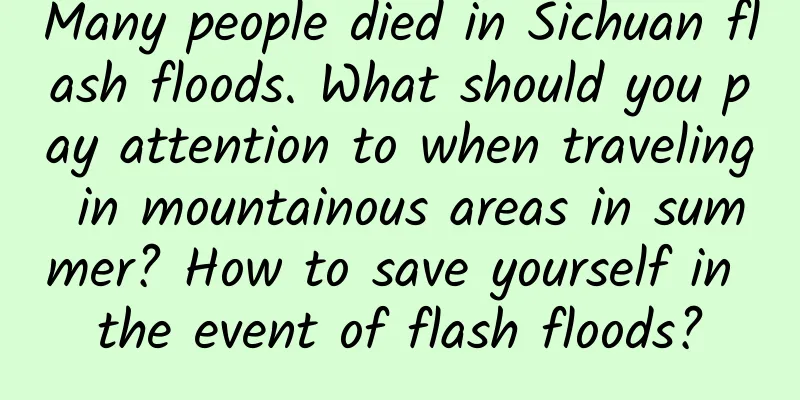Many people died in Sichuan flash floods. What should you pay attention to when traveling in mountainous areas in summer? How to save yourself in the event of flash floods?

|
In the past two days, the flash flood in Longcaogou, Longmenshan Town, Pengzhou City, Sichuan Province has attracted public attention. On the afternoon of August 13, a flash flood occurred in Longcaogou, Longmenshan Town, killing many people. Summer is the peak season for tourists to visit mountainous areas, and it is also the period when flash floods are more frequent. So, what exactly is a flash flood? When encountering a flash flood, what self-rescue methods do we have? What should tourists pay attention to when visiting mountainous areas in summer? 01 How are flash floods formed? Flash floods are sudden floods that occur in mountain streams and creeks . They are characterized by suddenness, concentrated water volume, high flow rate, and strong scouring and destructive power . Flash floods carry mud and even stones in their flow. They and the debris flows and landslides they induce often cause casualties, damage houses, fields, roads and bridges, and may even cause dams and ponds to burst, causing very serious harm. The terrain in areas prone to flash floods is often characterized by high mountains, steep slopes, deep valleys, large cutting depths, and well-developed erosion gullies. Most of the geology is soil with low permeability, such as mudstone and shale, which have weak erosion resistance and are easily softened and disintegrated when exposed to water, which is extremely conducive to the rapid convergence of surface runoff after heavy rainfall. Once encountering a strong surface runoff impact, flash floods will occur. Unstable climate systems in hilly areas often cause continuous or concentrated high-intensity rainfall. According to statistics, flash floods are mainly caused by excessive rainfall in the affected areas, which makes the soil saturated and the surface loose. After a short-term heavy rainfall, the rainfall quickly gathers into surface runoff, causing rapid rises in stream water levels, mudslides, collapses, and landslides . From the overall physical process of occurrence and development, it can be seen that flash floods are mainly caused by continuous rainfall and short-term heavy rainfall. In addition, human activities may also cause flash floods. For example, excessive land development in hilly areas, or reclamation of steep slopes, or engineering construction that damages the mountains, changes the topography and landforms, destroys natural vegetation, cuts down forests indiscriminately, and loses the water conservation function, all of which are prone to flash floods. Image source: pexels 02 Things to pay attention to when encountering flash floods As mentioned above, mountainous areas are prone to flash floods. Therefore, when we walk or rest in the mountains, we should pay special attention to abnormal changes around the site and the retreat routes we can choose, think of self-rescue methods in advance, and evacuate the scene quickly in case of abnormal situations. When encountering flash floods, remember the following points: 1. When it feels like the rainfall is too heavy and there is a possibility of flooding, you should evacuate to higher places such as mountain tops or highlands in an organized manner in advance. 2. When you are suddenly hit by a flash flood in a mountainous area, you must remain calm and evacuate as quickly as possible. When leaving the scene, you should choose the nearest safe route and run horizontally along the hillside . Never run down the hillside or downstream along the valley exit. 3. Mountain torrents flow rapidly and rise quickly. Do not swim to avoid being swept away by the torrents. Also, be careful to prevent injuries from landslides, boulders, and mud-rock flows. 4. When trapped on high hills, terraces or sturdy residential buildings with solid foundations, you should be patient and wait for rescue, or wait for the steeply rising and falling flood to subside. 5. If you are caught off guard and trapped by floodwaters in low-lying riverbanks, earthen ridges or wooden houses, in critical situations, you can use communication tools to report your trapped situation to the local government and flood control departments and seek rescue. If there are no communication conditions, you can wave brightly colored clothes back and forth to call for help, so that rescuers can find you more easily. If conditions permit, you can also use boats, rafts, door panels, wooden beds and other floating objects to transfer on the water. 6. When you find that the high-voltage tower is tilted, the wires are hanging low or broken, stay away from it and do not touch or approach it to prevent electric shock. In addition, we should learn these disaster prevention knowledge in normal times. If we wait until we encounter a flash flood before learning any self-rescue methods, it will be too late and the probability of survival may be very low. 03 What should you pay attention to when traveling to the mountains in summer Tourists like to go to mountainous areas to escape the heat in summer, but summer is the peak season for geological disasters, so it is best not to go . If you want to go, in addition to being careful of floods, you must also be careful of landslides, mud-rock flows, lightning and other disasters. It is best to go to mountainous areas when there is no heavy rainfall . Pay attention to the weather forecast to check whether there are any geological disaster warnings or lightning warnings. When visiting mountainous areas, try to stay away from areas with low vegetation coverage, complex terrain, and unstable surface. Also, be careful to stay away from areas with hazard warning signs. See watermark for source You must obey the arrangements of the mountain management staff. It is reported that before the Longcaogou flood, the management staff tried to persuade tourists to leave, but no one paid attention to him. He repeatedly shouted: "I kneel down to you, please, the water is about to rise, please run." But no one paid attention to him. The local government has also issued many notices to remind tourists not to go to Longcaogou to play in the water or camp. This reminds us to obey the arrangements and instructions of the government and local managers, not to act on our own, and to have awe for nature. Warning signs were posted at the scene of the incident. See the watermark for the source of the image. In addition, when traveling to mountainous areas, you should be careful not to fall or get lost, and avoid going to undeveloped areas. At present, my country has gained considerable experience in flash flood warning and emergency rescue, gradually formed effective emergency plans, and established a trustworthy rescue team. But the best way to avoid danger is to take precautions before it happens. It is better not to go to mountainous areas or rivers during the flood season. END Tadpole Musical Notation original article, please indicate the source when reprinting Editor/Heart and Paper |
<<: The legendary "bird without feet" turns out to be right next to us!
>>: What kind of wine is good for your health before going to bed?
Recommend
Beijing's 50M broadband has shrunk five times
Premier Li Keqiang urged to increase Internet spe...
Latest warning! Guangzhou is facing the strongest "water splashing mode" this year, please be sure to take precautions
Latest warning! Guangzhou welcomes the heaviest r...
Exclusive ranking of “Werewolf Killing” App: Can “killing each other through the air” become the next Kuaishou?
"I still don't understand what Werewolf ...
Fenghuo Cross-border Product Director Training Camp, industry leaders jointly develop and solve industry bottlenecks
Fenghuo Cross-border Product Director Training Ca...
Are the "gerbils" that drink water with their ears in "Dune 2" real?
The cute "Jerboa" that appeared in the ...
Summary of Android and IOS promotion skills
Many products now spend their time and energy on ...
Why do men with impotence often fart? Clinical research gives the authoritative answer!
Recently, the COVID-19 epidemic has reached a cli...
Facing the termination order of operation, I summarized three points of work reflection:
I just saw a Weibo post about Zuckerberg's ex...
Are lampreys, the "underwater vampires", scary? Scientists discover that their carnivorous ancestors were even more "fierce"!
"Underwater vampire" - the ancestors of...
The whole process of product operation from 0 to 1
The main purpose of this article is to share my p...
You have watched a lot of doomsday science fiction movies, but have you ever thought about where is the best place to take refuge?
Written by: Qi Dazai Layout: Li Xuewei If global ...
Troubleshooting starts with error code 406
background A while ago, I was suddenly informed b...
Is it possible for a person to eat only one thing?
Some time ago, the epidemic broke out in many pla...
New features for the Android version of Chrome are here: support for image editing
On June 25, according to XDA, Google has added im...









